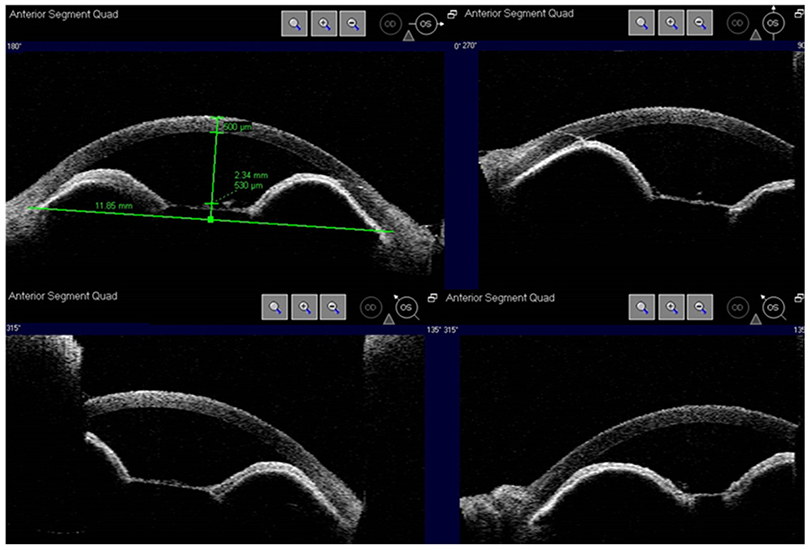J Korean Ophthalmol Soc.
2019 Aug;60(8):797-801. 10.3341/jkos.2019.60.8.797.
Pseudophakic Pupillary Block after Toxic Anterior Segment Syndrome
- Affiliations
-
- 1Department of Ophthalmology, Asan Medical Center, University of Ulsan College of Medicine, Seoul, Korea. jkwon0620@naver.com
- KMID: 2455464
- DOI: http://doi.org/10.3341/jkos.2019.60.8.797
Abstract
- PURPOSE
We report a case of pseudophakic pupillary block after toxic anterior segment syndrome (TASS).
CASE SUMMARY
An 84-year-old woman underwent phacoemulsification and intraocular lens implantation in the posterior chamber. Six days after surgery, anterior chamber inflammation was seen. Twenty-five days after surgery, a sudden increase in intraocular pressure (IOP) associated with pupillary block was observed. Despite the use of IOP-lowering medication, the IOP was not controlled. Peripheral laser iridotomy failed. After surgical peripheral iridectomy, IOP decreased significantly and was controlled.
CONCLUSIONS
Despite the rarity of TASS combined with pseudophakic pupillary block, clinicians must be aware of this condition in patients showing prolonged inflammatory state and IOP elevation after surgery.
MeSH Terms
Figure
Reference
-
1. Gaton DD, Mimouni K, Lusky M, et al. Pupillary block following posterior chamber intraocular lens implantation in adults. Br J Ophthalmol. 2003; 87:1109–1111.
Article2. Samples JR, Bellows AR, Rosenquist RC, et al. Pupillary block with posterior chamber intraocular lenses. Arch Ophthalmol. 1987; 105:335–337.
Article3. Vajpayee RB, Angra SK, Titiyal JS, et al. Pseudophakic pupillary-block glaucoma in children. Am J Ophthalmol. 1991; 111:715–718.
Article4. Holland SP, Morck DW, Lee TL. Update on toxic anterior segment syndrome. Curr Opin Ophthalmol. 2007; 18:4–8.
Article5. Hwang KY, Yang JW, Lee YC, Kim SY. Toxic anterior segment syndrome following cataract surgery. J Korean Ophthalmol Soc. 2011; 52:690–695.
Article6. Ozcelik ND, Eltutar K, Bilgin B. Toxic anterior segment syndrome after uncomplicated cataract surgery. Eur J Ophthalmol. 2010; 20:106–114.
Article7. Sarobe Carricas M, Segrelles Bellmunt G, Jiménez Lasanta L, Iruin Sanz A. Toxic anterior segment syndrome (TASS): studying an outbreak. Farm Hosp. 2008; 32:339–343.
Article8. Cetinkaya S, Dadaci Z, Aksoy H, et al. Toxic anterior-segment syndrome (TASS). Clin Ophthalmol. 2014; 8:2065–2069.
Article
- Full Text Links
- Actions
-
Cited
- CITED
-
- Close
- Share
- Similar articles
-
- Four Cases of Toxic Anterior Syndrome after Cataract Surgery under Intracameral 0.5% Lidocaine Anesthesia
- The Measurement of the Apparent Accommodation with AA-2000 Accommodometer
- A Case of Pupillary Block Glaucoma with Familial Exudative Vitreoretinopathy
- Development of Toxic Anterior Segment Syndrome Immediately after Uneventful Phaco Surgery
- Pupillary Block Following Phacoemulsification with Foldable Intraocular Lens Implantation in Adults





